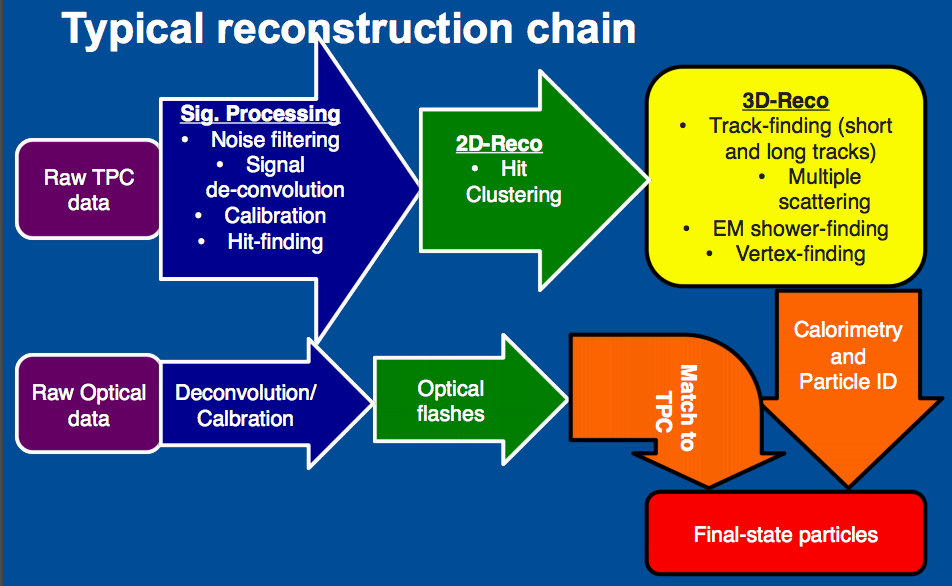Introduction
CERN had a one-day LArSoft tutorial designed for those who are joining reconstruction and analysis efforts in Liquid Argon experiments but are new to the LArSoft framework. These sessions were video recorded. The recordings are available along with the presentations – see the links at the end of this write-up.
Organizers of the event would like to acknowledge Marzio Nessi for supporting the event and Audrey Deidda and Harri Toivonen for their significant help with solving organizational issues.
LArSoft tutorial overview

The participants came from many scientific research fields, not only from the Liquid Argon community, so in the morning session, the Liquid Argon TPC technology was presented. This introduction included discussion of a number of the challenges related to detection technology as well as challenges in data reconstruction and analysis. This background was followed with a short introduction to the LArSoft framework.
The morning hands-on session was led by Theodoros Giannakopoulos who did an introductory talk about the organization of the Neutrino Cluster at CERN. He also covered part of the LArSoft installation and explained how to set up the environment in Neutrino Cluster machines.
During the hands-on session, most of the participants logged into the Neutrino Cluster nodes using their own laptops with their own favorite operating system and shell. Having computing experts there was very important, especially Theodoros Giannakopoulos who was extremely helpful.
The purpose of the hands-on session was to learn how to run simulation and reconstruction jobs in LArSoft and how to visualize events to inspect results. As an example we chose 2 GeV/c test beam pion in the ProtoDUNE-SP geometry. Robert Sulej’s slides guided participants during the hands-on session. In many places, we pointed to the in-depth materials from the Fermilab LArSoft tutorial and also linked to slides from the YoungDUNE tutorial, e.g. event display slides were very helpful.
The afternoon session started with a talk by Wesley Ketchum titled “Reconstruction as analysis.” The reconstruction in Liquid Argon is a challenging task, but developing reconstruction algorithms to overcome a problem is also a great source of satisfaction. It is also very important to make progress in the Liquid Argon data analysis. As Wes said, it is the “process of taking raw data to physically-meaningful quantities that can be used in a physics analysis.” Wes presented an overview of reconstruction algorithms in LArSoft and several use cases from MicroBooNE data analysis experience.

Wes prepared examples for the afternoon hands-on session during which he introduced Gallery as a light-weight tool for simulation and reconstruction results analysis appropriate also for the exploratory work before code is moved to the LArSoft framework. A short introduction was followed by coding examples. The last part of the hands-on session explained how to “write and run your own module, step by step.”
Participants learned about the organization of LArSoft modules and algorithms and their configuration files. The aim of the coding exercise was to access information stored in data products (clusters) and associations between them (hits assigned to clusters) so participants could make histograms of simple variables such as number of cluster. They also had the opportunity to learn about matching the reconstruction results to the simulation truth information.
Two weeks after the tutorial, several people are still in contact with us, progressing with their understanding of the framework and starting their real developments. The tutorial reached many members of double phase LArTPC technology. This shows the advantages of having a detector agnostic approach where development efforts can be efficiently used. In the end we are all heading towards the same physics goals.
Links to Material
The video from the morning session is available here. It covers the following presentations:
- LArTPC detector basics, ProtoDUNE, DUNE goals – Dorota Stefan(CERN/NCBJ (Warsaw PL))
- Introduction to LArSoft and DUNE tools – Robert Sulej, (FNAL / NCBJ)
- Tutorial part I – Dorota Stefan (CERN/NCBJ (Warsaw PL)) , Wesley Ketchum (Fermi National Accelerator Laboratory) , Robert Sulej (FNAL / NCBJ)
Note, you need a CERN user account to access cluster and do exercises using preinstalled software. It is possible to use local installation on a laptop. See the information at the beginning of the Indico page about the session.
The video from the afternoon session is available here. It covers the following presentations:
- Reconstruction as analysis? – Wesley Ketchum (Fermi National Accelerator Laboratory)
- Tutorial part II – Wesley Ketchum (Fermi National Accelerator Laboratory) , Robert Sulej (FNAL / NCBJ) , Dorota Stefan (CERN/NCBJ (Warsaw PL))
— Dorota Stefan & Katherine Lato